Master the Wok: Ultimate Stir-Fry Guide
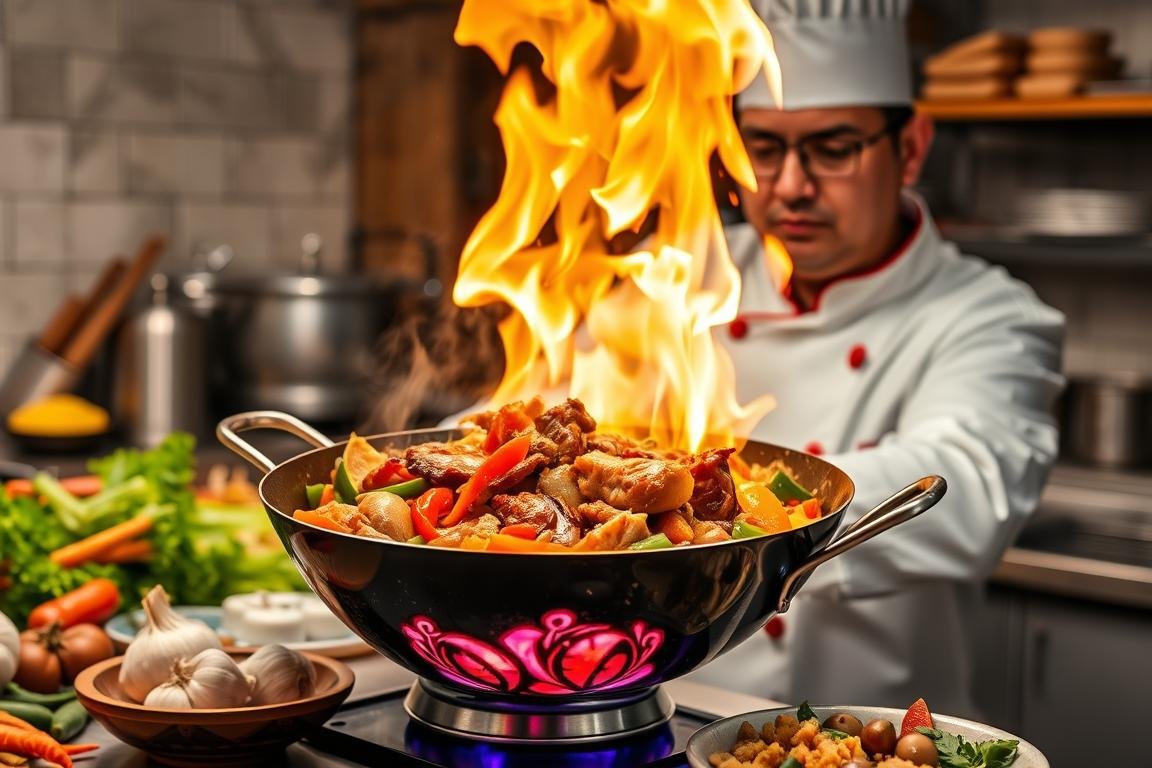
Have you ever thought about the power of a single pan? Welcome to stir-frying. This is an old cooking method that is still very popular. It is used from China’s busy markets to kitchens in the United States. The high-heat basic cooking techniques of wok cooking give us tasty dishes. These are known in Chinese cuisine and Asian cuisine.
Stir-frying cooks food quickly at high temperatures. You keep moving the food to cook it well and fast. This technique started a long time ago, during the Eastern Zhou period. It has become a key way to make quick meals. These meals are full of taste but easy to make. Whether you’re new to this or want to get better, our guide has traditional and modern tips. We want to help you master stir-fry.
The wok is not just a pan. It’s a symbol of cooking well and having new ideas. Why is its shape and material so good for cooking? And what exactly is wok hei that makes food lovers excited? Join us to find out these things. Learn the top tips for stir-frying and improve your kitchen skills with our guide.
Key Takeaways
- Discover the rich history of stir-frying, tracing back to ancient China, and how it has shaped modern Chinese cuisine.
- Understand why a wok is the preferred choice over a skillet for the unique heat distribution that is paramount to authentic stir-frying.
- Learn about the significance of a seasoned wok in adding another layer of flavor to your quick meals.
- Explore the flavor-enhancing phenomenon of wok hei – the hallmark of true high-heat wok cooking.
- Gain insights into the coveted “hot wok, cold oil” method and why mastering it is essential for successful stir-frys.
- Embrace the role of practice in mastering the dynamic and swift movement needed in wok cooking.
Introduction to Stir-Frying
Stir-frying started in China over 1,500 years ago. It’s known for quick meals that are tasty and healthy. This method uses high heat and fast cooking. It’s been popular for 400 years because it saves fuel.
What is Stir-Frying?
Stir-frying means cooking chopped food fast on high heat. This is often done in a wok. The wok’s shape helps cook food well. Foods like meat and veggies are cooked quickly to keep them crunchy and full of vitamins.
Benefits of Stir-Frying
Stir-frying is good because it’s healthy. It uses less oil and keeps food’s natural tastes. It also keeps the vitamins in veggies. It’s quick and works for many diets.
Using a wok or skillet, high-heat cooking is key in stir-frying. It makes food flavorful and nicely textured. Chef J. Kenji López-Alt likes washing meat before stir-frying. This makes the meat better in taste and feel.
Stir-frying improves your cooking skills. It also helps you eat better and save time, perfect for today’s busy life. It keeps traditional Asian cooking alive.
Essential Stir-Fry Ingredients
Jumping into Asian cooking means learning about stir-fry basics. We will look at picking top-notch items for your veggie or meat stir-fry. These choices will lift your dish to new heights.
Choosing the Right Proteins
Proteins are key for any stir-fry. You might choose tofu, chicken, beef, or shrimp. The type and prep of your protein shapes your meal. Marinate your choice for 10-15 minutes to make it tasty and soft. A bit of water in the marinade makes it juicy.
Picking Fresh Vegetables
Veggies bring color and crunch. They are also good for your health. Use fresh, firm ones and cut them the same size for even cooking. Some, like broccoli or carrots, should be blanched first. This keeps them crisp and cooked right.
The Importance of Aromatics
Garlic, ginger, and onions are key smells in many Asian dishes. Sauté these right before adding the main stuff to make the oil tastier. This way, their scent stands out but doesn’t hide other tastes.
It’s also key to pick the right oil. Use avocado or peanut oil for their high smoke points. This lets you cook at high heat without burning your food.
Knowing how these elements work together is key to stir-fry mastery. With the right ingredients and skills, you’ll make awesome authentic stir-fries at home.

Choosing the Right Equipment
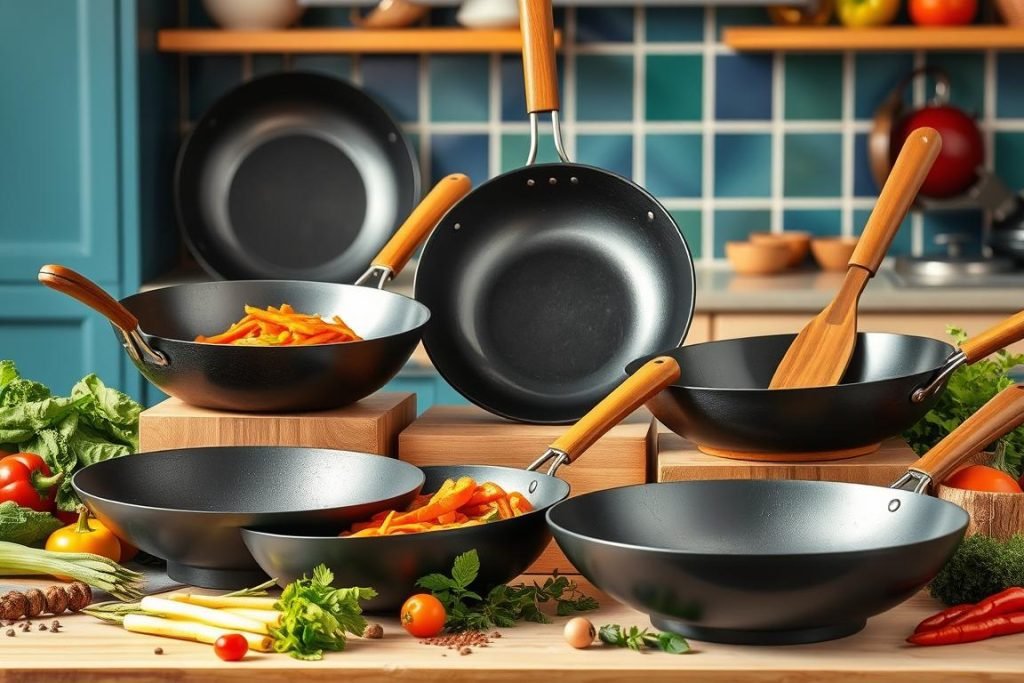
Starting with the right gear is key for wok cooking, especially if you love Asian food. Your choices are important. They affect how well you can make those vibrant stir-fries.
Best Woks for Stir-Frying
Look for woks that heat up quickly and adjust to temperature changes well. This is crucial for fast stir-frying. Carbon steel and cast iron are great because they get hot quickly and keep the heat even. Traditional round-bottom woks are great but might need a wok ring for modern stoves. Flat-bottom ones work well on electric or induction cooktops without extra stuff.
Essential Utensils and Tools
- Knife: A sharp chef’s knife is crucial for preparing your ingredients finely and uniformly, ensuring they cook evenly.
- Cutting Board: Opt for a durable, sizeable cutting board to handle all the chopping and slicing that Asian cuisine demands.
- Spatula: Choose a long-handled, heat-resistant spatula for safely stirring and tossing ingredients at high temperatures.
To really get good at stir-frying, you need to upgrade your kitchen tools. When picking your gear, think about Dalstrong’s Oberon Series. Their 12″ Frying Pan Wok has a lasting non-stick surface. It also has high walls that are perfect for tossing and stirring lots of ingredients.
Preparing Your Ingredients
Getting your stir-fry right starts with good prep. Make sure your veggies, proteins, and flavor add-ins are ready. This base ensures a yummy, healthy meal. It brings traditions of Asian cooking to your kitchen. The crisp of veggies and the taste of meat or tofu matter a lot.
How to Cut Vegetables for Stir-Frying
The cut of your veggies is key for a good fry. Make sure vegetables like broccoli and carrots are cut the same size. This way, they’ll cook together well. Even slices also soak up flavors in every bite.
Marinating Proteins Effectively
Choosing the right marinade makes proteins tastier. Use meats or plant-based foods like tofu. A good mix of savory and sweet in your marinade works wonders. It makes your protein tender and flavorful. Perfect for an impressive stir-fry.
Prepping Aromatics
Ingredients like garlic and ginger add deep flavors. Chop or grate them to get the best taste. Doing this before you start cooking is a smart move. It lets you focus on frying like a pro.
Prepping everything well means every part of your stir-fry will be perfect. The flavors will blend just right. It’s a healthy and delicious meal everyone will love.

Stir-Frying Techniques
Stir-frying mixes art and science, especially in Chinese cuisine. Learning this cooking technique means knowing how to handle heat and time. And how to work with different foods.
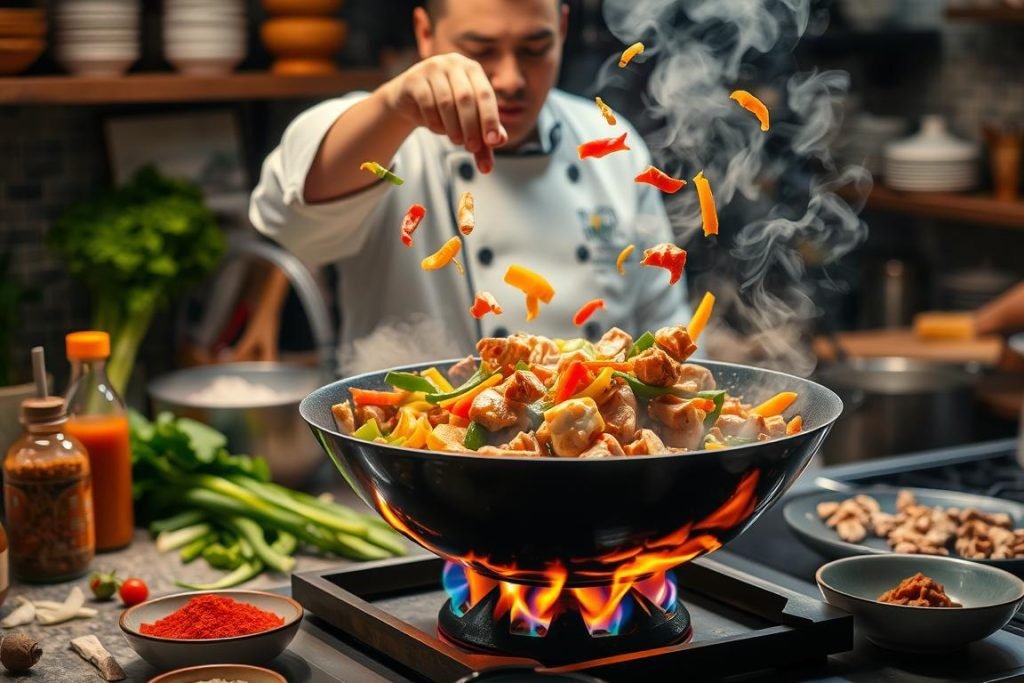
The Power of High Heat
High-heat cooking is key for stir-frying. It locks in flavor and keeps everything bright and crunchy. A very hot wok gives us ‘wok hei’, a special smoky taste. This method cooks foods like thin meat slices and veggies just right. They get a tasty edge but keep their good stuff.
Tossing vs. Stirring
Tossing is better than stirring for even cooking. Tossed ingredients cool a bit. They don’t get too hot. This makes each piece cook just right. It helps the dish feel and taste the same all through.
Timing Your Ingredient Additions
Adding things at the right time is important. Start with proteins like chicken or beef. They need time to brown and taste great. Then add hard veggies like carrots and bell peppers. After, put in fast-cooking stuff like greens and garlic. This makes sure everything is perfectly cooked at the same time.
Using these cooking techniques makes your stir-frying better. You’ll enjoy making and eating your dishes. They’ll be tasty and healthy, just like in Chinese cuisine.
Flavoring Your Stir-Fry
Making your stir-fry tasty is about more than just adding stuff to a wok. The right mix of stir-fry sauces, seasoning, and cooking method makes a simple dish rich and authentic. It’s great for anyone who wants quick meals that are still full of flavor.
Sauces That Elevate the Dish
Some sauces are key to making stir-fry dishes stand out. Here are some favorites:
- Soy sauce for a salty depth
- Oyster sauce and hoisin sauce for adding a sweet and savory umami richness
- Fish sauce to enrich dishes with a bold, anchovy-infused flavor
With these options, your stir-fry will be far from plain. They make your ingredients taste amazing.
Seasoning Basics and Beyond
Seasoning is also crucial for that perfect stir-fry flavor. Here are some common ones used:
- Sichuan peppercorns which offer a tingling, bold kick
- Five-spice powder, a blend that provides a warmth and complexity
- Fresh ingredients like ginger and garlic, which provide foundational flavors
Seasoning your stir-fry well makes every bite delicious. Asian cooking loves mixing sweet, salty, sour, bitter, and umami tastes. This mix works for all dishes, with meat or veggies.
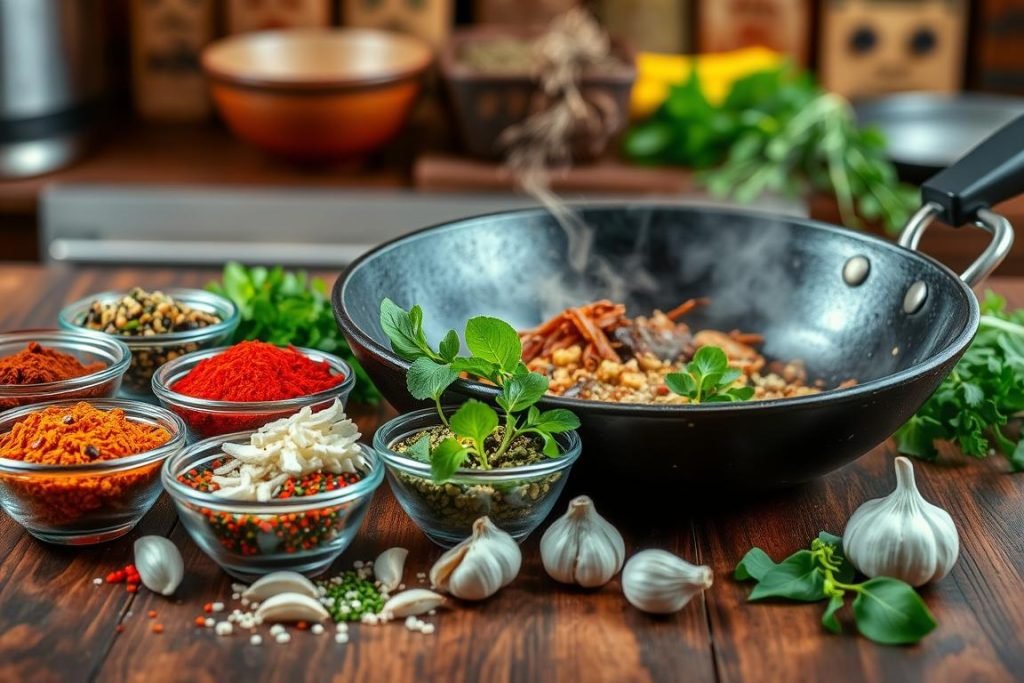
The real magic of stir-fry isn’t just what you put in it. It’s also how you prepare and cook those ingredients. Keeping your eye on how flavors blend with the right heat and timing is key. Get good at these, and your home cooking will rival the best Asian spots.
| Sauce Type | Primary Flavors | Common Uses |
|---|---|---|
| Soy Sauce | Salty, umami | Base sauce for meats and vegetables |
| Oyster Sauce | Sweet, rich umami | Meats, tofu, vegetables |
| Fish Sauce | Salty, fishy | Accentuating ready dishes |
| Hoisin Sauce | Sweet, slightly spicy | Glazes, marinades, dipping |
To sum up, great stir-fry is about more than just how you cook. Flavorful sauces and seasonings turn simple things into amazing dishes. They are vital to Asian cooking and for making quick meals that taste wonderful.
Common Stir-Fry Mistakes to Avoid
Stir-frying is a big part of Asian cooking. It needs you to pay attention to details. Both beginners and experienced cooks must avoid certain mistakes. Doing so makes your stir-fry both tasty and crispy.
Overcrowding the Pan
Adding too much to the pan is a big no-no. It makes your food soggy instead of crispy. You should cook each thing one at a time. This keeps the pan hot and makes everything crisp and flavorful.
Ignoring the Heat
Stir-frying needs high heat. This heat gives it a special smoky taste. Use oils like canola or avocado that can handle the heat. Keep your pan hot and keep stirring. This makes sure your food is seared right and tastes great.
Not Preparing Ingredients Properly
Getting ready is important for a good stir-fry. Cut everything into small, even pieces before you start. This helps everything cook right and look good. Your goal is to avoid common mistakes and make a tasty dish.

Following these tips will make your meal delicious. It shows how skilled and precise you are in cooking Asian food. Remember, making a stir-fry is simple and fast if you do it right.
| Ingredient | Preparation Tips | Common Mistakes |
|---|---|---|
| Proteins (Chicken, Beef, Tofu) | Slice into thin, even pieces. Marinate if desired. | Using uneven or overly large pieces can lead to undercooking. |
| Vegetables (Bell Peppers, Broccoli, Carrots) | Chop into uniform shapes. Categorize by cooking times. | Add all at once leading to some being overcooked while others are raw. |
| Oil | Choose oils with high smoke points like canola or grapeseed. | Using delicately flavored oils like olive, which may burn easily. |
Next time, make sure your skills and techniques are ready. This will help you make amazing Asian food.
Meal Prep with Stir-Frying
Stir-frying makes cooking quick meals easy. It’s both healthy and yummy. You can prepare a good dinner quickly on busy nights. Stir-frying changes how you cook.
Quick Weeknight Dinners
Stir-frying cuts down kitchen time but keeps food quality high. Most meals take under 10 minutes. It uses little oil, keeping meals healthy. Try mixing lean chicken, bell peppers, and broccoli. These cook fast with homemade sauce.
Batch Cooking Ideas
Meal prep lovers benefit from stir-frying. It cooks large amounts fast. Perfect for weekly meal prep. Just increase ingredients and cook in batches. Then, save portions for later.
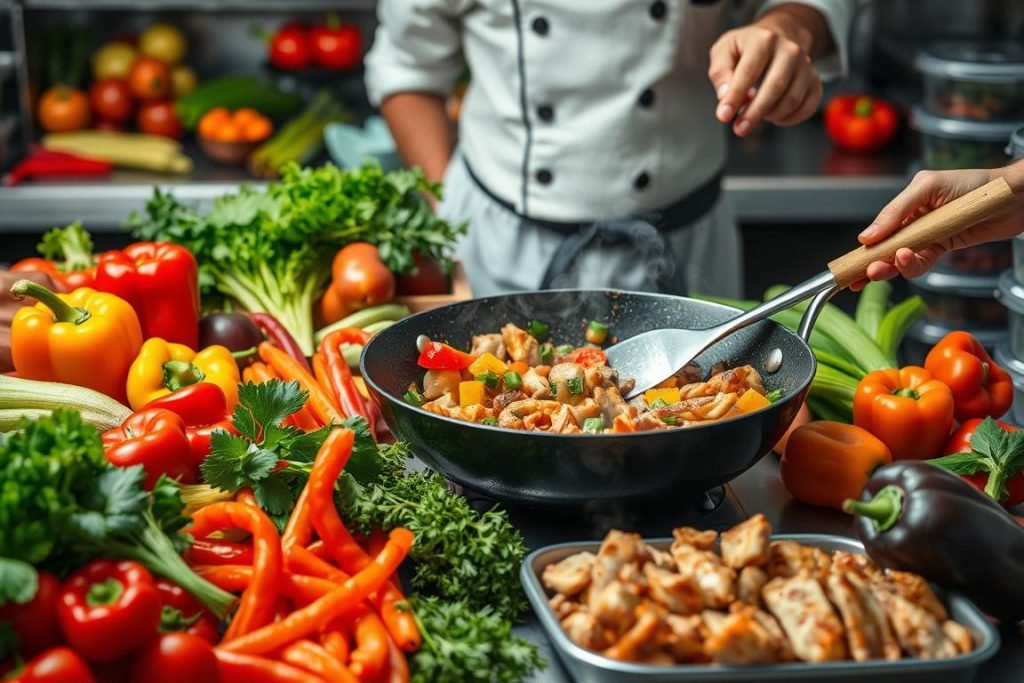
See the table for cook times and info on stir-fry ingredients. It helps with meal planning.
| Recipe | Prep Time | Cook Time | Total Time | Servings | Calories per Serving | Ingredients |
|---|---|---|---|---|---|---|
| Velveted Chicken | 45 min | 10 min | 55 min | 14 | 166 kcal | 2268 g chicken, 45 g soy sauce, 120 g egg whites, 20 g cornstarch |
| Pickled Carrots | 0 min | 10 min | 10 min | 10 | 15 kcal | 200 g carrots, 360 g water, 360 g vinegar, 12 g sugar, 6 g salt |
| Basic Stir Fry Sauce | 0 min | 5 min | 5 min | 10 | 26 kcal | 360 g chicken stock, 120 g soy sauce, 48 g oyster sauce, 35 g mirin, 15 g water, 16 g cornstarch |
You can make velveted chicken or a quick sauce. Stir-frying is great for tasty, healthy cooking. It fits a busy life.
Vegetarian and Vegan Stir-Fry Options
Want to make your kitchen life very exciting? Try vegetarian and vegan stir-fry dishes. They make cooking fun with lots of flavors and textures. These meals are healthy and full of plant proteins.
Plant-Based Proteins to Include
Kickstart your vegetarian and vegan cooking journey with the right proteins. Tofu, tempeh, and edamame give dishes a meaty feel. Beans add a satisfying fullness. For flavorful tofu stir-fry, first cook tofu in broth or water. Do this on high heat for 3-5 minutes. This way, it soaks up flavors well.
| Ingredient | Cooking Time | Texture Contribution |
|---|---|---|
| Tofu | 3-5 minutes | Meaty and absorbent |
| Tempeh | 5-6 minutes | Firm and grainy |
| Edamame | 2-3 minutes | Crunchy and fresh |
| Beans (e.g., black, kidney) | Stir in last to heat through | Hearty and filling |
Combining Flavor and Nutrition
Making a good vegan stir-fry means mixing flavors and nutrition. Start with hard veggies like carrots and cauliflower. They cook in 6-10 minutes. Softer veggies like broccoli and peas cook faster, in 3-4 minutes. Flavor it with ginger and garlic. Sauté these in water or broth for deep taste.
A great stir-fry sauce makes your dish better. Make an all-purpose sauce with pineapple, garlic, and ginger. Add soy sauce and a bit of arrowroot powder to thicken it. This sauce makes your stir-fry both healthy and delicious.
Add scallions and sesame seeds at the end to keep their crunch. This makes your dish taste and look better.

These tips help make your stir-fry dishes a hit. With plant proteins, your meals are hearty and healthy. Your veggie stir-fries will be full of taste and goodness.
Conclusion: Stir-Fry Mastery Awaits
You’ve learned about stir-fry and how it’s a key part of Asian cooking. You now know how important it is to get everything ready before you start cooking. This way, you can turn plain ingredients into amazing meals. A good wok, like the All-Clad D3 Stainless Steel 14-inch Wok, is essential. It makes sure the heat spreads evenly.
This is vital for perfect stir-frying. Woks work well with oils like peanut or canola. These oils can handle high temperatures. You can make quick meals like Costco yakisoba stir fry or even your own recipes. The wok is your friend in making delicious food.
Encouragement to Experiment
Wok cooking is all about practicing. This makes you better at mixing ingredients quickly. Remember, you can always try new things with stir-fry. You can use different meats, mix new flavors, and cook veggies just right. They’ll stay crisp and nutritious.
Keep learning and trying new things in your stir-fry journey. You’ve learned a lot from over ten years of wok cooking. Be bold in your cooking. Remember, stir-frying is about adding your own touch as much as following techniques.
Final Tips for Stir-Fry Success
Becoming a stir-fry expert means paying attention to what makes it special. Choose a good wok. A 14-inch one with a flat bottom is great for most kitchens. It’s easy to use.
When you deep-fry, keep the oil hot but not too full. This keeps things crispy. Enjoy making healthy and tasty meals that are full of tradition. These tips will help you master stir-frying and make food that you and others will love.